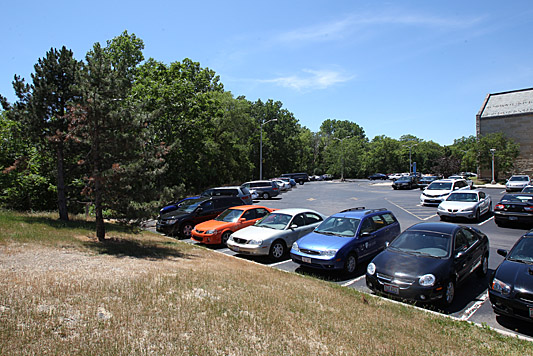Approximately 100 trees on the bank of the Ottawa River near the Law Center on Main Campus are being cut down as work continues on the waterway’s restoration.

Trees on the north bank of the Ottawa River by the Law Center parking lot are being cleared so that a cut bank can be created as part of the waterway’s restoration.
Aaron Tree and Lawn of Toledo will undertake the clearing project.
“Initial design work on the river restoration determined that we need to create a cut bank area that will allow for more water storage during higher river levels,” Lawrence said. “We didn’t anticipate this when the project started, but it’s a requirement for a federal permit.
“Removing these trees is a necessity, not a choice,” he emphasized. “This area adjacent to the Law Center parking lot is the only site requiring extensive tree removal for the river restoration project. And replanting — from grasses to small trees and shrubs — is part of the overall plan.”
A $235,000 grant from the Ohio Environmental Protection Agency and a $111,000 grant from the U.S. Fish and Wildlife Service are funding the Ottawa River restoration.
Once the trees are cleared, a section will be dug out to create the cut bank and widen the land on the north side of the river at that site.
Lawrence explained that phase two of the restoration calls for adding in-stream elements with natural materials — rock, tree trunks, wood — to create changes in water flow, and that has the potential to affect the 100-year flood level in the river.
“When you do work like that in a river, you can’t raise the water level more than it would rise naturally,” he said. “We haven’t had an event like that for decades, but you have to design for it just in case.”
The cut bank will have long-term benefits.
“The area will be more open and accessible to people. It’ll be a great opportunity to have an overlook to the river on the north bank by the Law Center and maybe put in a trail and benches,” Lawrence said. “There’s no funding for those now in this project, but we are optimistic for the future to search for grants and other means.”
Phase two of the restoration will begin in August 2013 when the in-stream elements are added to create diversity in the river. Interpretative signage will be placed along the waterway to explain the work to the campus community and visitors.
This demonstration and education project will mean more fish and wildlife.
“We have more than 40 fish species in the river. This summer we’ve also been noting muskrats, deer, turtles, frogs, blue heron, mallard ducks and Canada geese,” Lawrence said. “This is a living river, a natural corridor that we’re lucky to have on our campus.
“The Ottawa River has its issues and challenges, but it has a lot of potential if we can improve the aquatic and forest habitat along the 3,700 feet through Main Campus.”